NCERT Solutions for Class 10 Maths Chapter 3 Exercise 3.1 - Pair of Linear Equations in two variables
CBSE Class 10th Exam Date:01 Jan' 26 - 14 Feb' 26
The exercise explains how to solve a pair of linear equations through graphical methods. The lesson establishes how two linear equations display as straight lines on a Cartesian coordinate system, where their point of intersection reveals the solution. The visualisation enables learners to determine the solution possibilities based on the line behaviour of lines intersecting or being parallel, or coinciding. The process reveals how algebra functions together with geometric principles to solve problems that exist in the real world.
This Story also Contains
- NCERT Solutions Class 10 Maths Chapter 3: Exercise 3.1
- Access Solution of Pair of Linear Equations in Two Variables Class 10 Chapter 3 Exercise: 3.1
- Topics covered in Chapter 3 Pair of Linear Equations in Two Variables: Exercise 3.1
- NCERT Solutions of Class 10 Subject Wise
- NCERT Exemplar Solutions of Class 10 Subject Wise

Understandings of two-variable linear equation behaviour in graphical representations are taught in this essential section of the NCERT Solutions for Class 10 Maths. Students who perform exercise gain deeper comprehension about linear equation graphical solutions and system consistency, and how it determines unique versus infinite solutions. The clear presentation of the solutions given in the NCERT Books enables students' understanding of the connection between graphical interpretations and algebraic processes before moving on to complex multisystem topics in higher education.
Access Solution of Pair of Linear Equations in Two Variables Class 10 Chapter 3 Exercise: 3.1
Answer:
Let the number of boys be x and the number of girls be y.
Now, according to the question,
Total number of students in the class = 10, i.e.
$\Rightarrow x+y=10.....(1)$
And, given that the number of girls is 4 more than the number of boys it means; $x=y+4$
$\Rightarrow x-y=4..........(2)$
Different points (x, y) satisfying equation (1)
X | 5 | 6 | 4 |
Y | 5 | 4 | 6 |
Different points (x,y) satisfying equation (2)
X | 5 | 6 | 7 |
y | 1 | 2 | 3 |
Graph,
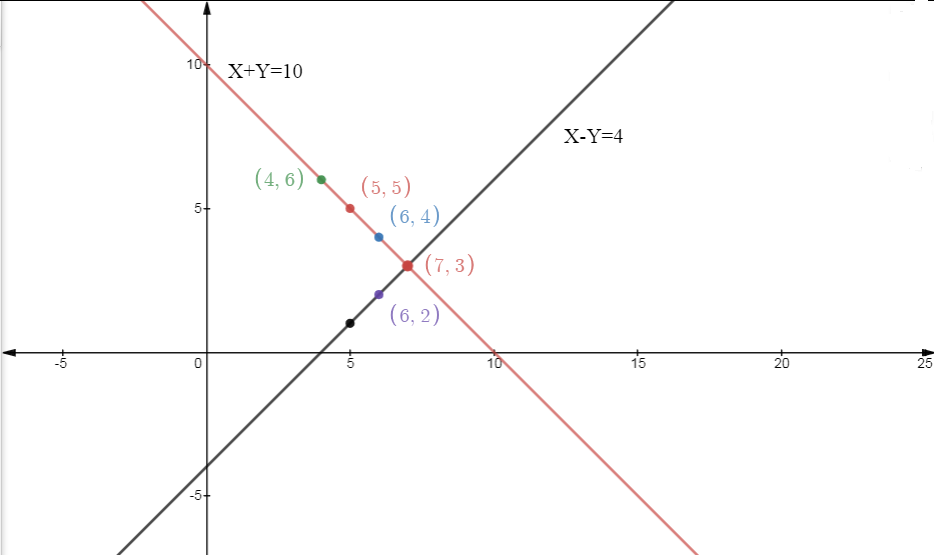
From the graph, both lines intersect at the point (7,3). That is x = 7 and y = 3, which means the number of boys in the class is 7 and the number of girls in the class is 3.
Answer:
Let the price of 1 pencil be x, and y be the price of 1 pen.
Now, according to the question
$5x+7y=50......(1)$
And
$7x+5y=46......(2)$
Now, the points (x,y) that satisfy the equation (1) are
X | 3 | -4 | 10 |
Y | 5 | 10 | 0 |
And, the points (x,y) that satisfy the equation (2) are
X | 3 | 8 | -2 |
Y | 5 | -2 | 12 |
The Graph,
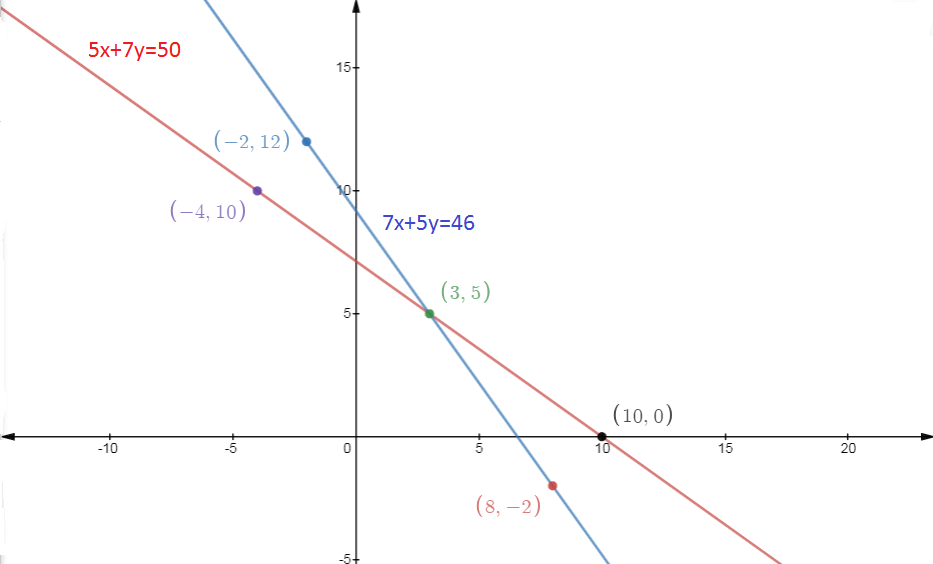
From the graph, both lines intersect at point (3,5), that is, x = 3 and y = 5, which means the cost of 1 pencil is 3 and the cost of 1 pen is 5.
Answer:
Given Equations,
$\\5x - 4y + 8 = 0 $and$ 7x + 6y - 9 = 0$
Comparing these equations with $a_1x+b_1y+c_1=0\:and\:a_2x+b_2y+c_2=0$ , we get
$\frac{a_1}{a_2}=\frac{5}{7},\:\frac{b_1}{b_2}=\frac{-4}{6}\:and\:\frac{c_1}{c_2}=\frac{8}{-9}$
It is observed that;
$\frac{a_1}{a_2}\neq\frac{b_1}{b_2}$
It means that both lines intersect at exactly one point and have a unique solution.
Answer:
Given Equations,
$\\9x + 3y + 12 = 0$ and $18x + 6y + 24 = 0$
Comparing these equations with $a_1x+b_1y+c_1=0\:and\:a_2x+b_2y+c_2=0$ , we get
$\\\frac{a_1}{a_2}=\frac{9}{18}=\frac{1}{2},\\\:\frac{b_1}{b_2}=\frac{3}{6}=\frac{1}{2}\: and \\\:\frac{c_1}{c_2}=\frac{12}{24}=\frac{1}{2}$
It is observed that;
$\frac{a_1}{a_2}=\frac{b_1}{b_2}=\frac{c_1}{c_2}$
It means that both lines are coincident and have infinitely many solutions.
Q2 (iii) On comparing the ratios $\frac{a_1}{a_2}$, $\frac{b_1}{b_2}$and $\frac{c_1}{c_2}$ , find out whether the lines representing the following pairs of linear equations intersect at a point, are parallel or coincident: (iii) $\\6x - 3y + 10 = 0; \\ 2x - y+ 9 = 0$
Answer:
Given Equations,
$\\6x - 3y + 10 = 0$ and$ 2x - y+ 9 = 0$
Comparing these equations with $a_1x+b_1y+c_1=0\:and\:a_2x+b_2y+c_2=0$ , we get
$\frac{a_1}{a_2}=\frac{6}{2}=3,\:\frac{b_1}{b_2}=\frac{-3}{-1}=3\:and\:\frac{c_1}{c_2}=\frac{10}{9}$
It is observed that;
$\frac{a_1}{a_2}=\frac{b_1}{b_2}\neq\frac{c_1}{c_2}$
It means that both lines are parallel and thus have no solution.
Answer:
Given Equations,
$\\3x + 2y = 5$ and $2x - 3y = 7$
Or, $3x + 2y - 5 = 0$ and $ 2x - 3y - 7 = 0$
Comparing these equations with $a_1x+b_1y+c_1=0\:and\:a_2x+b_2y+c_2=0$ , we get
$\frac{a_1}{a_2}=\frac{3}{2},\:\frac{b_1}{b_2}=\frac{2}{-3}\:and\:\frac{c_1}{c_2}=\frac{5}{7}$
It is observed that;
$\frac{a_1}{a_2}\neq\frac{b_1}{b_2}$
It means that the given equations have a unique solution and thus the pair of linear equations is consistent.
Answer:
Given Equations,
$\\2x - 3y = 8$ and $4x - 6y = 9$
Or, $\\2x - 3y - 8 = 0$ and $4x - 6y - 9 = 0$
Comparing these equations with $a_1x+b_1y+c_1=0\:and\:a_2x+b_2y+c_2=0$ , we get
$\\\frac{a_1}{a_2}=\frac{2}{4}=\frac{1}{2},\\\:\frac{b_1}{b_2}=\frac{-3}{-6}=\frac{1}{2}\:and\\\:\frac{c_1}{c_2}=\frac{8}{9}$
It is observed that;
$\frac{a_1}{a_2}=\frac{b_1}{b_2}\neq\frac{c_1}{c_2}$
It means the given equations have no solution, and thus the pair of linear equations is inconsistent.
Answer:
Given Equations,
$\\\frac{3}{2}x + \frac{5}{3}y = 7$ and $9x -10y = 14$
Or, $\\\frac{3}{2}x + \frac{5}{3}y - 7 = 0$ and $9x -10y - 14 = 0$
Comparing these equations with $a_1x+b_1y+c_1=0\:and\:a_2x+b_2y+c_2=0$ , we get
$\\\frac{a_1}{a_2}=\frac{3/2}{9}=\frac{3}{18}=\frac{1}{6},\\\:\frac{b_1}{b_2}=\frac{5/3}{-10}=\frac{5}{-30}=-\frac{1}{6}\:and\\\:\frac{c_1}{c_2}=\frac{7}{14}=\frac{1}{2}$
It is observed that;
$\frac{a_1}{a_2}\neq\frac{b_1}{b_2}$
It means the given equations have exactly one solution, and thus the pair of linear equations is consistent.
Answer:
Given Equations,
$5x - 3y = 11$ and $-10x + 6y =-22$
Or, $5x - 3y - 11 = 0$ and $-10x + 6y + 22 = 0$
Comparing these equations with $a_1x+b_1y+c_1=0\:and\:a_2x+b_2y+c_2=0$ , we get
$\\\frac{a_1}{a_2}=\frac{5}{-10}=-\frac{1}{2},\\\:\frac{b_1}{b_2}=\frac{-3}{6}=-\frac{1}{2}\:and\\\:\frac{c_1}{c_2}=\frac{11}{-22}=-\frac{1}{2}$
It is observed that;
$\frac{a_1}{a_2}=\frac{b_1}{b_2}=\frac{c_1}{c_2}$
It means the given equations have an infinite number of solutions, and thus a pair of linear equations is consistent.
Answer:
Given Equations,
$\\\frac{4}{3}x + 2y = 8$ and $2x + 3y = 12$
Or, $\\\frac{4}{3}x + 2y - 8 = 0$ and $2x + 3y - 12 = 0$
Comparing these equations with $a_1x+b_1y+c_1=0\:and\:a_2x+b_2y+c_2=0$ , we get
$\\\frac{a_1}{a_2}=\frac{4/3}{2}=\frac{4}{6}=\frac{2}{3},\\\:\frac{b_1}{b_2}=\frac{2}{3}\:\:and\\\:\frac{c_1}{c_2}=\frac{8}{12}=\frac{2}{3}$
It is observed that;
$\frac{a_1}{a_2}=\frac{b_1}{b_2}=\frac{c_1}{c_2}$
It means the given equations have an infinite number of solutions, and thus a pair of linear equations is consistent.
Answer:
Given Equations,
$\\x + y = 5$ and $2x + 2 y = 10$
Comparing these equations with $a_1x+b_1y+c_1=0\:and\:a_2x+b_2y+c_2=0$ , we get
$\\\frac{a_1}{a_2}=\frac{1}{2},\\\:\frac{b_1}{b_2}=\frac{1}{2}\:and\\\:\frac{c_1}{c_2}=\frac{5}{10}=\frac{1}{2}$
It is observed that;
$\frac{a_1}{a_2}=\frac{b_1}{b_2}=\frac{c_1}{c_2}$
It means the given equations have an infinite number of solutions, and thus a pair of linear equations is consistent.
The points (x,y) which satisfy both equations are
X | 1 | 3 | 5 |
Y | 4 | 2 | 0 |
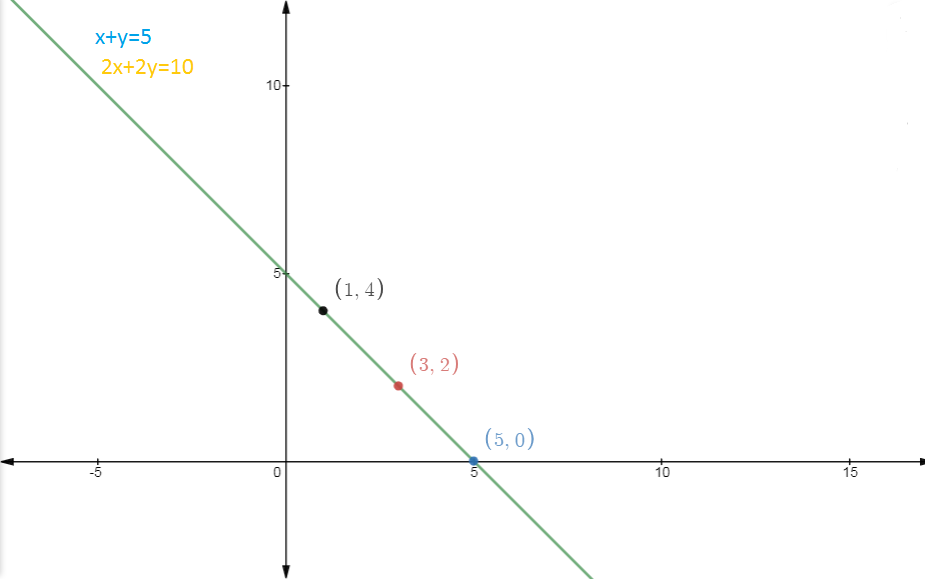
Answer:
Given Equations,
$\\x - y = 8$ and $3x - 3y = 16$
Comparing these equations with $a_1x+b_1y+c_1=0\:and\:a_2x+b_2y+c_2=0$ , we get
$\\\frac{a_1}{a_2}=\frac{1}{3},\\\:\frac{b_1}{b_2}=\frac{-1}{-3}=\frac{1}{3}\:and\\\:\frac{c_1}{c_2}=\frac{8}{16}=\frac{1}{2}$
It is observed that:
$\frac{a_1}{a_2}=\frac{b_1}{b_2}\neq\frac{c_1}{c_2}$
It means the given equations have no solution, and thus the pair of linear equations is inconsistent.
Answer:
Given Equations,
$\\2x + y - 6 =0$ and $4x - 2 y - 4 = 0$
Comparing these equations with $a_1x+b_1y+c_1=0\:and\:a_2x+b_2y+c_2=0$ , we get
$\\\frac{a_1}{a_2}=\frac{2}{4}=\frac{1}{2},\\\:\frac{b_1}{b_2}=\frac{1}{-2}=-\frac{1}{2}\:and\\\:\frac{c_1}{c_2}=\frac{-6}{-4}=\frac{3}{2}$
It is observed that;
$\frac{a_1}{a_2}\neq\frac{b_1}{b_2}$
It means the given equations have exactly one solution, and thus the pair of linear equations is consistent.
The points(x, y) satisfying the equation $\\2x + y - 6 =0$ are,
X | 0 | 2 | 3 |
Y | 6 | 2 | 0 |
And The points(x,y) satisfying the equation $\\4x - 2y - 4 = 0$ are,
X | 0 | 1 | 2 |
Y | -2 | 0 | 2 |
GRAPH:
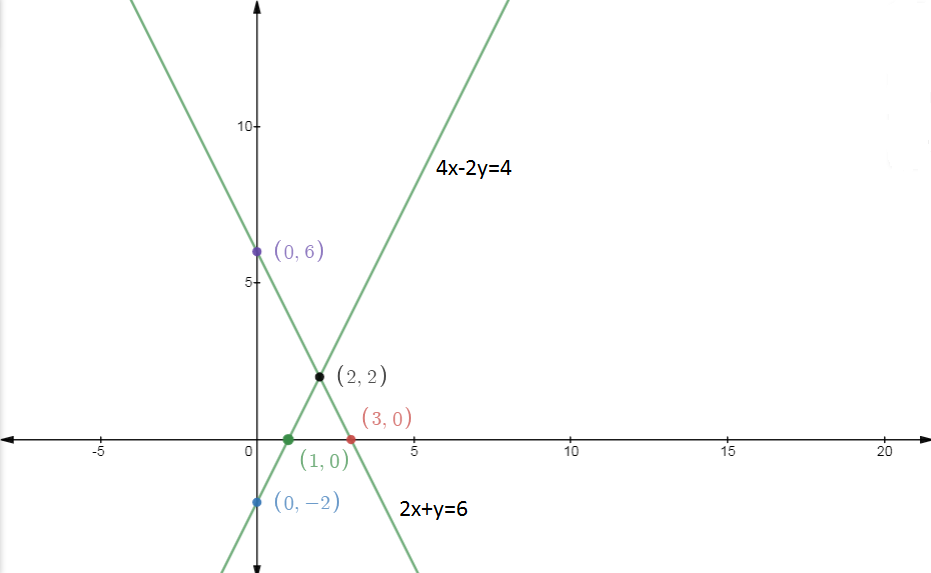
As we can see, both lines intersect at point (2,2) and hence the solution of both equations is x = 2 and y = 2.
Answer:
Given Equations,
$\\2x - 2y - 2 =0, \qquad\\ 4x - 4y -5 = 0$
Comparing these equations with $a_1x+b_1y+c_1=0\:and\:a_2x+b_2y+c_2=0$ , we get
$\\\frac{a_1}{a_2}=\frac{2}{4}=\frac{1}{2},\\\:\frac{b_1}{b_2}=\frac{-2}{-4}=\frac{1}{2}\:and\\\:\frac{c_1}{c_2}=\frac{-2}{-5}=\frac{2}{5}$
It is observed that;
$\frac{a_1}{a_2}=\frac{b_1}{b_2}\neq\frac{c_1}{c_2}$
It means the given equations have no solution, and thus the pair of linear equations is inconsistent.
Answer:
Let $ l$ be the length of the rectangular garden and $b$ be the width.
Now, according to the question, the length is 4 m more than its width, so we can write it as $l=b+4$
Or, $l-b=4....(1)$
Also given Half Parameter of the rectangle = 36 it means $l+b=36....(2)$
Now, as we have two equations, add both equations, and we get,
$l+b+l-b=4+36$
$\Rightarrow 2l=40$
$\Rightarrow l=20$
We get the value of $l$, which is 20m
Now, putting this in equation (1), we get;
$\Rightarrow 20-b=4$
$\Rightarrow b=20-4$
$\Rightarrow b=16$
Hence, the Length and width of the rectangle are 20m and 16m, respectively.
Answer:
Given the equation,
$2x + 3y -8 =0$
We know that the condition for the intersection of lines for the equations in the form $ a_1x+b_1y+c_1=0$ and $ a_2x+b_2y+c_2=0$ is,
$\frac{a_1}{a_2}\neq\frac{b_1}{b_2}$
So any line with this condition can be $4x+3y-16=0$
Proof,
$\frac{a_1}{a_2}=\frac{2}{4}=\frac{1}{2}$
$\frac{b_1}{b_2}=\frac{3}{3}=1$
Hence, $\frac{1}{2}\neq1$ it means $\frac{a_1}{a_2}\neq\frac{b_1}{b_2}$
Therefore, the pair of lines has a unique solution, thus forming intersecting lines.
Answer:
Given the equation,
$2x + 3y -8 =0$
As we know that the condition for the parallel lines for the equations in the form $ a_1x+b_1y+c_1=0$ and $ a_2x+b_2y+c_2=0$ is,
$\frac{a_1}{a_2}=\frac{b_1}{b_2}\neq\frac{c_1}{c_2}$
So any line with this condition can be $4x+6y-8=0$
Proof,
$\frac{a_1}{a_2}=\frac{2}{4}=\frac{1}{2}$
$\frac{b_1}{b_2}=\frac{3}{6}=\frac{1}{2}$
$\frac{c_1}{c_2}=\frac{-8}{-8}=1$
Hence, $\frac{1}{2}=\frac{1}{2}\neq1$ it means $\frac{a_1}{a_2}=\frac{b_1}{b_2}\neq\frac{c_1}{c_2}$
Therefore, the pair of lines has no solutions; thus lines are parallel.
Answer:
Given the equation,
$2x + 3y -8 =0$
As we know that the condition for the coincidence of the lines for the equations in the form $ a_1x+b_1y+c_1=0$ and $ a_2x+b_2y+c_2=0$ is,
$\frac{a_1}{a_2}=\frac{b_1}{b_2}=\frac{c_1}{c_2}$
So any line with this condition can be $4x+6y-16=0$
Proof,
$\frac{a_1}{a_2}=\frac{2}{4}=\frac{1}{2}$
$\frac{b_1}{b_2}=\frac{3}{6}=\frac{1}{2}$
$\frac{c_1}{c_2}=\frac{-8}{-16}=\frac{1}{2}$
Hence, $\frac{1}{2}=\frac{1}{2}=\frac{1}{2}$ it means $\frac{a_1}{a_2}=\frac{b_1}{b_2}=\frac{c_1}{c_2}$
Therefore, the pair of lines has infinitely many solutions; thus lines are coincident.
Answer:
Given two equations,
$x - y + 1=0.........(1)$
And
$3x +2 y - 12=0.........(2)$
The points (x,y) satisfying (1) are
X | 0 | 3 | 6 |
Y | 1 | 4 | 7 |
And The points(x,y) satisfying (2) are,
X | 0 | 2 | 4 |
Y | 6 | 3 | 0 |
GRAPH:
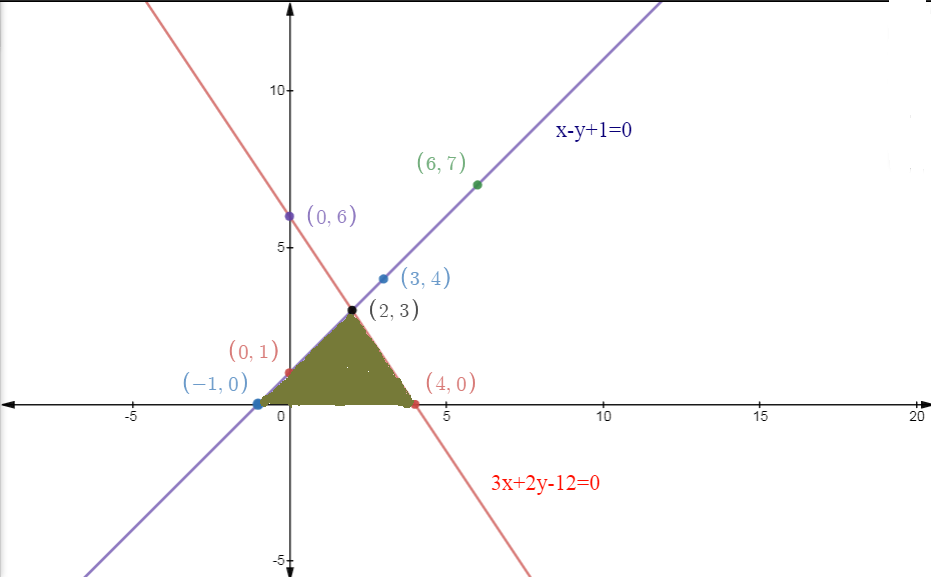
From the graph, we can see that both lines intersect at the point (2,3), and therefore the vertices of the Triangle are ( -1,0), (2,3) and (4,0). The area of the triangle is shaded with a green colour.
Also Read-
Topics covered in Chapter 3 Pair of Linear Equations in Two Variables: Exercise 3.1
1. Graphical Representation of Linear Equations: The process includes plotting linear equations on Cartesian graphs by using tables of values to draw their resulting straight lines.
2. Finding Solutions through Intersection Points: The intersection point between two lines indicates all solutions of the system while offering accurate insights into the equations.
3. Understanding Consistency of Systems: Knowing about System Consistency involves examining the graph to identify the number of solutions, along with determining whether the system follows a consistent or inconsistent or dependent pattern.
4. Types of Solutions: Unique solutions when lines intersect, No solutions when lines remain parallel and Infinite solutions occur with coinciding lines.
5. Verification of Solutions: The final verification involves testing whether graphically obtained solutions match both equations through substitution and transforming these results into calculations for accuracy verification.
Also see-
NCERT Solutions of Class 10 Subject Wise
Students must check the NCERT solutions for class 10 of Mathematics and Science Subjects.
NCERT Exemplar Solutions of Class 10 Subject Wise
Students must check the NCERT Exemplar solutions for class 10 of Mathematics and Science Subjects.
Frequently Asked Questions (FAQs)
If the equations are consistent and dependent, there are no solutions to linear equations in two variables.
You can go through the 10th class maths exercise 3.2 answers to get deeper understanding of the concepts related to equations are consistent and dependent. The requirement for linear equations in two variables is:
a1/a2 = b1/b2 = c1/c2
The basic strategy to represent the linear equations on the graph and determine the point of intersection is the graphical method of solution of a pair of linear equations.
The concepts related to linear equation is discussed in ex 3.2 class 10. Practice the problems discussed in this exercise to command the concepts. For this question, because of the term xy is of degree 2, xy - 9 = 3 is not a linear equation in two variables.
To understand the concepts of quadrants go through the problems discussed in class 10 maths ex 3.2. In a graph, there are four quadrants. a point can be represent in in a plain using the (x, y) coordinates.
To get in depth understanding of related concepts practice problems enumerated in the class 10 ex 3.2. as per these concepts, when two lines are in a plane, there are three alternative solutions. They really are.
- Two lines may intersect at times.
- Two lines may not intersect at times, and they may be parallel to each other.
- Two lines may be coincident at times.
In Class 10th Maths chapter 3 exercise 3.2, there are seven questions based on the notion of graphical representation of a system of equations.
Questions related to CBSE Class 10th
On Question asked by student community
The CBSE Sahodaya Question Papers for Class 10 (2025-26) are not released centrally by the board as a single PDF.
Here is the essential information you need:
-
Local Release: The papers are designed and released by the individual Sahodaya School Clusters (groups of CBSE schools) just before or during the pre-board exam dates (typically held in December and January). Therefore, you must check your local cluster's portal or directly with your school administration.
-
Best Practice: The official model papers, based on the full 2026 syllabus, are the most reliable tool for practice. These accurately reflect the structure, format, and competency-based questions used in the Sahodaya exams.
You can download the latest CBSE Class 10 Model Papers to simulate the Sahodaya tests here: https://school.careers360.com/articles/sahodaya-question-paper-2025 . Focus on that pattern
Hi! If you’re looking for the Class 11 English half yearly question paper for 2025-26 (CBSE board), you’ll find the right resource once you check the link provided from Careers360. Solving previous or sample papers is a smart way to prepare, as it helps you understand the question types, marking scheme, and important topics. This practice will boost your confidence and help you manage your time well in the actual exam.
https://school.careers360.com/boards/cbse/cbse-class-11-half-yearly-sample-papers-2025-26
Hi dear candidate,
Could you please specify us the board of education for which you need the half yearly question papers of class X so that we can help you further.
Below are few links which may help you and it has all the subjects with English as well:
CBSE Class 10 Half Yearly Exam Question Paper 2025-26 with Answer Key & Analysis
ICSE Class 10 Half Yearly Sample Papers 2025-26 PDF (All Subjects)
BEST REGARDS
Hi dear candidate,
Can you please specify the board of education or state for which you need to know the exam pattern and syllabus so that we can guide you accordingly.
Since, most of the boards uses NCERT as base syllabus, you can refer to the link below:
NCERT Syllabus for Class 10 – All Subjects PDF Download 2025-26
Exam pattern:
CBSE 10th New Exam Pattern 2026- Marking Scheme, Subject-Wise Exam Pattern
BEST REGARDS
The CBSE Class 10th Board Exams for the 2026 session will follow the revised curriculum, emphasizing competency-based questions.
-
Conducting Body: Central Board of Secondary Education (CBSE).
-
Exam Period: The main theory exams are typically held between February and April 2026.
-
Grading: Based on marks in five main subjects plus internal assessment marks (often 20 marks per subject) provided by the school.
-
Passing Criteria: You must achieve at least 33% overall in each subject (theory + practical/internal assessment combined) to be declared pass.
Key Preparation Strategy
The most crucial element of your preparation is understanding the exam structure:
-
Syllabus: Strictly adhere to the rationalized syllabus released by CBSE for the 2025-26 academic year.
-
Practice: Your primary resource should be the latest sample papers and previous year question papers. These accurately reflect the format and types of competency questions being asked.
For the most comprehensive and official announcements, including the detailed time table and access to crucial practice materials, always check the official board updates, as tracked by Careers360: https://school.careers360.com/exams/cbse-class-10th .
Applications for Admissions are open.
As per latest syllabus. Physics formulas, equations, & laws of class 11 & 12th chapters
JEE Main Important Chemistry formulas
Get nowAs per latest syllabus. Chemistry formulas, equations, & laws of class 11 & 12th chapters
JEE Main high scoring chapters and topics
Get nowAs per latest 2024 syllabus. Study 40% syllabus and score upto 100% marks in JEE
JEE Main Important Mathematics Formulas
Get nowAs per latest syllabus. Maths formulas, equations, & theorems of class 11 & 12th chapters
